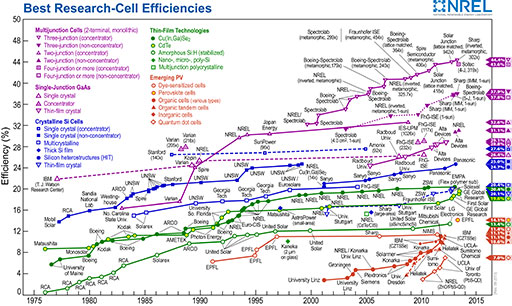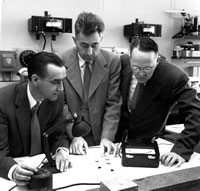5.5 Electricity from sunlight
We have just looked at batteries as a means of storing energy. Next we will look at ways in which energy can be generated usefully in the first place.
We have had means of producing energy from fossil fuels for several centuries, and from nuclear reactions since the 1960s. But what about one of the current engineering challenges – power from sunlight?
Solar radiation can be harvested directly in two ways: as heat or as electricity. Here we will concentrate on the direct generation of electricity. Photovoltaics (PV), the current technology for achieving this, has many advantages compared to other sources of electricity. It is modular, free from maintenance and suitable for urban and remote applications alike. These are also some of the attributes of batteries, so watch out for the differences.
Photovoltaics
Like the words 'news' and 'electronics', I will be using 'photovoltaics' as a singular plural. It sounds awkward at first. Electronics has played a major part in the technological revolution of recent years. Photovoltaics is a major subset of electronics.
The term photovoltaic derives for the Greek word for light – photo – and the term volt for electromotive force. So photovoltaic implies an electromotive force from light. Although its use has greatly increased in recent years and is still accelerating, the true worth of photovoltaics is yet to be fully realised.
The photovoltaic effect was first observed in 1839 by the French scientist Alexandre-Edmond Becquerel (1820–1891), the father of the more famous Henri Becquerel who discovered radioactivity. He noticed an increase in a wet battery's voltage when its silver plate electrodes were exposed to light. In 1877 the photovoltaic effect was observed in the solid material selenium, and in 1883 an American inventor, Charles Fritts, made a selenium photovoltaic cell. It was very inefficient, converting less than 1% of light falling on it into electricity.
It was to take the revolution in understanding of the fundamental properties of materials and of light in the early twentieth century to explain these effects. The development of modern solar cells had to wait until the electronics revolution of the 1950s. Calvin Chapin, Daryl Fuller and Gerald Pearson of Bell Labs (Figure 89) produced the first silicon cell in 1953. By the following year a cell efficiency of 6% had been achieved.
Photovoltaic solar cells have been used for power in space since the launch of the Vanguard 1 satellite in 1958. These cells are the power source of choice for space missions within the inner solar system because of their high reliability and zero-maintenance properties – the benefits of having no moving parts! But it was not until the global oil crisis of 1972 that development of terrestrial applications also became significant.
In parallel with developments for users in remote areas, there has also been the provision of photovoltaic cells for low-power consumer goods, such as watches, calculators and low-level garden lighting where convenience is the key. Now there is a large range of areas in which photovoltaics offers a viable alternative to conventional means of power production.
Throughout the development of photovoltaics, efficiency (the ratio of electrical output to incident solar power) has increased and cost has come down significantly. There are now many ground-based (or 'terrestrial') applications that are viable (see, for example, Figure 90).

The search for low-cost, highly efficient solar cells is the subject of intensive research efforts worldwide. The National Renewable Energy Laboratory in the USA produces regularly updated data on progress in this area. Figure 91 shows a chart produced in late 2013.
An efficiency approaching 40% has been produced with exotic materials in the laboratory, and under some circumstances it has been possible to exceed 40%. In production an efficiency of 15% is straightforward to achieve and it is possible to buy modules with 19% efficiency. There are perfectly satisfactory explanations of this rather low efficiency which we'll come to in due course.
Photovoltaic cells are convenient for some portable power systems: pocket calculators have used low performance cells for many years; the exploration and exploitation of space would be considerably more expensive and difficult without PV technology. PV technology provides a solution too in remote locations that are otherwise without power: cathodic protection of pipelines, radio signal boosting, weather stations and power for isolated communities are all candidates for PV systems. A double benefit can be gained with mobile recharging systems for laptop computers, portable music systems and mobile phones, as portable equipment is here taken for use into remote locations. Large PV systems integrated into roofs or office buildings in urban environments and connected to the mains network have considerable appeal, but such concepts are better built-in from the start and many of our urban developments are not easily adaptable.
This part of Section 5 is an overview of photovoltaics: how it works, what materials are employed, and its likely place in the future scheme of energy generation and implementation.
The generation of useful electricity from sunlight is clearly a major engineering challenge. However, it should be examined in the overall context of power generation and the growing use of 'renewable' energy sources. This is the aim of the following section. I will then go on to look at just how sunlight can be used as an energy resource, before studying in more detail the technology and engineering of modern photovoltaic cells.

Activity 41 (exploratory)
Go to Best research-cell efficiencies [Tip: hold Ctrl and click a link to open it in a new tab. (Hide tip)] to bring up the latest version of the chart in Figure 91. Compare the charts to see how much progress has been made since mid-2012 (the time of writing of this course).
- a.Which technology has made the largest incremental improvement in efficiency?
- b.Which seems to be currently the most actively researched?
- c.What other criteria, besides efficiency, do you think play a part in determining the practical and commercial viability of a given type of photovoltaic cell?

